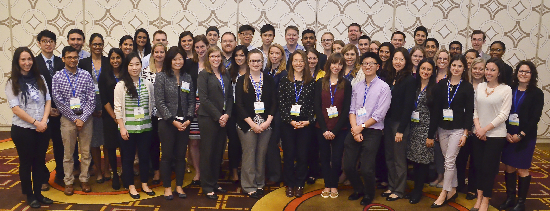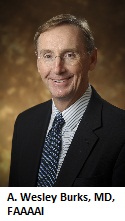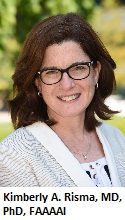From the President

Chrysalis Project participants pose for a group photo at the 2016 AAAAI Annual Meeting in Los Angeles.
Dear Colleagues,
 One of my presidential initiatives is focused on facilitating development of the next generation of allergy/immunology educators and investigators. If we ignore this important task, the future of our specialty will be grim. Once again the words of Abraham Lincoln are very fitting: “The best way to predict your future is to create it.”
One of my presidential initiatives is focused on facilitating development of the next generation of allergy/immunology educators and investigators. If we ignore this important task, the future of our specialty will be grim. Once again the words of Abraham Lincoln are very fitting: “The best way to predict your future is to create it.”
Since 1999, we have been working to create our specialty’s future through the AAAAI’s Chrysalis Project. Currently co-chaired by Wesley Burks, MD, FAAAAI, and Kimberly Risma, MD, PhD, FAAAAI, it aims to attract future generations to choose allergy/immunology—by introducing medical students and residents to the science and careers within the specialty.
To get a better sense of how the Chrysalis Project accomplishes this, I asked Wesley Burks to explain in more detail:
 “The Chrysalis Project is centered on a unique three-day program that takes place at each AAAAI Annual Meeting. The 50 medical students or internal medicine and pediatric residents who are accepted for the 2017 Chrysalis Project will attend the 2017 Annual Meeting for free. Their travel, accommodations for three nights, and a $250 stipend to cover reasonable expenses for meals and ground transportation are also provided.
“The Chrysalis Project is centered on a unique three-day program that takes place at each AAAAI Annual Meeting. The 50 medical students or internal medicine and pediatric residents who are accepted for the 2017 Chrysalis Project will attend the 2017 Annual Meeting for free. Their travel, accommodations for three nights, and a $250 stipend to cover reasonable expenses for meals and ground transportation are also provided.
There are several components to the Chrysalis Project which make it very comprehensive. First is the Chrysalis educational program that covers the pathogenesis and treatment of allergic and immunologic disorders along with cutting-edge research. Additionally, A/I career options are presented including academic medicine, private practice and industry. Second is dedicated time for participants to attend their choice of Annual Meeting sessions being presented by leading experts in the field. Third is access to fellow-in-training (FIT) mentors who can answer participants’ questions about the specialty and guide them through the Annual Meeting educational sessions and events. Finally, we host a Chrysalis luncheon and reception so participants have opportunities to network with A/I training program directors, Chrysalis faculty and the FIT mentors. Participants are also invited to attend the AAAAI President/President-Elect Reception that takes place Friday evening during the Annual Meeting.”
As you’ve now heard, the Chrysalis Project offers medical students or internal medicine and pediatric residents a unique experience. The reality is that many medical schools offer very limited exposure to allergy/immunology, so the Chrysalis Project affords us the opportunity to bridge that gap. Using Chrysalis to build a pipeline of candidates for our allergy/immunology training programs is crucial to facilitate development of the next generation of allergy/immunology educators and investigators.
In order to dig deeper into how successful Chrysalis has been at building this applicant pipeline, I’ve asked Co-Chair Kimberly Risma to talk about some recent outcomes research that was completed:
 “We recently emailed an online survey to 385 former Chrysalis attendees dating back to 1999. The goal of the survey was to determine the percentage of participants who entered allergy/immunology fellowship or clinical practice (private practice, academic or industry). Of 135 respondents who have completed primary residency in medicine or pediatrics, 99 (73%) are currently allergy/immunology fellows-in-training or allergy/immunology specialists in practice. A subgroup of respondents (n=46) were students in MD/PhD programs or physician scientist graduates while attending Chrysalis. Of the 29 physician scientists who have already completed their primary residency, 20 (69%) have chosen allergy/immunology.
“We recently emailed an online survey to 385 former Chrysalis attendees dating back to 1999. The goal of the survey was to determine the percentage of participants who entered allergy/immunology fellowship or clinical practice (private practice, academic or industry). Of 135 respondents who have completed primary residency in medicine or pediatrics, 99 (73%) are currently allergy/immunology fellows-in-training or allergy/immunology specialists in practice. A subgroup of respondents (n=46) were students in MD/PhD programs or physician scientist graduates while attending Chrysalis. Of the 29 physician scientists who have already completed their primary residency, 20 (69%) have chosen allergy/immunology.
We are highly encouraged by this data as it speaks to the importance of the Chrysalis program to attract talented trainees to our field. In particular we hope to provide an ongoing pipeline of future allergy/immunology investigators whose careers will make valuable contributions to the clinical and basic sciences.”
As a former Chrysalis Chair, I also find the survey results extremely encouraging as they illustrate the return on investment we see from Chrysalis. My thanks go to Kimberly Risma and Wesley Burks for their contributions to this message and the work they do to oversee the program.
Do you know someone who is interested in a future career in the specialty? Applications for the 2017 Chrysalis Project are being accepted until October 28. Our next group of Chrysalis participants may very well include some of our specialty’s future leaders.
Sincerely,

Thomas A. Fleisher, MD, FAAAAI
AAAAI President

![[0]](/images/template/btn-menu.gif)

